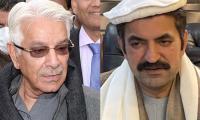IMF and other supporters say the move will clean the complete economic system; opponents say it will hurt small industries, farmers, GDP; Indian police claim the move crippled Communist guerrilla groups like Naxalites financing through money laundering; Modi govt allegedly informed some tycoons about plan in advance
LAHORE: There is no doubt that a chaos had certainly engulfed the whole of India after Premier Narendra Modi declared Rs 500 and Rs 1000 currency notes of the Mahatama Gandhi Series illegal on November 8, 2016, but his demonetisation scheme surely has its vocal advocates and critics both.
But before we revisit and review the positive and negative reactions, both at home and abroad, about the Indian demonetisation policy, it is imperative to note that while announcing his government’s policy for the replacement of the Rs 500 and Rs 1000 banknotes on November 8, Prime Minister Modi had claimed that the step under review was initiated to halt counterfeiting of the current banknotes, to crackdown on black money, and to harness the surging corruption levels.
In his televised address, Modi had also alleged that the banned Rs 500 and Rs 1000 banknotes were being used for funding terrorism. The Indian Premier had also described the move as an effort to reduce the use of drugs, and check smuggling.
According to the policy, Indian citizens were allowed to tender their old banknotes at any office of the Reserve Bank of India or any bank branch and credit the value into their respective bank accounts until December 30, 2016.
Cash withdrawals from bank accounts were restricted to Rs 10,000 per day and Rs 20,000 per week per account from November 10 to 13, 2016, though this limit was increased to Rs 24,000 per week from November 14.
Initially, all ATMs were dispensing banknotes of only Rs 50 and Rs 100 denominations and cash withdrawals from ATMs were restricted to Rs 2000 per day. From November 14 onwards, ATMs recalibrated to dispense new Rs 500 and Rs 2000 notes will allow a maximum withdrawal of Rs 2,500 per day, while other ATMs dispensing banknotes of only Rs 50 and Rs 100 denominations will allow a maximum withdrawal of Rs 2000 per day.
On October 28, 2016, the total banknotes in circulation in India, according to the Reserve Bank of India, was equivalent to US$260 billion In March 2016, the Reserve Bank of India had stated that total bank notes in circulation was valued at US$240 billion, of which nearly 86 per cent or around US$210 billion was in form of Rs 500 and Rs 1000 banknotes.
In terms of volume, the Indian Central Bank report said, around 24 per cent or $22.03 billion of the total 90,266 million banknotes were in circulation.
(References: Reserve Bank of India, NDTV India, The Hindu, India Today, The Times of India, Al-Jazeera, the Huffington Post, the Indian Express, the Economic Times, the Hindustan Times, the Telegraph. Kolkota and Ministry of Finance, Government of India etc)
Remember, the Government of India had also devised an Income Declaration Scheme between June and September 2016 for holders of black money and had urged them through media to come out clean by declaring the assets, paying the tax and penalty of 45 per cent.
The scheme had yielded Rs 652.50 billion from 64,275 declarations with 45 per cent of it as the revenue to the government.
Appreciation of the Indian scheme: Indian President Pranab Mukherjee had welcomed the demonetisation move by calling it a bold step.
Finance Minister Arun Jaitley viewed that demonetisation would clean the complete economic system; increase the size of economy and revenue base.
Indian Nation Congress spokesman Randeep Surjewala hailed the move but remained skeptical on the consequences that would follow.
Chief Minister of Bihar Nitish Kumar and Chief Minister Andhra Pradesh Nara Naidu also lauded demonetisation.
Arundhati Bhattacharya (Chairman State Bank of India), Chanda Kochar (CEO of ICICI Bank), business magnate Anand Mahindra (Mahindra Group), Narayana Murthy (Infosys Group) and Sajjan Jindal (Jindal Group) etc had supported the move.
The IMF issued a statement supporting Modi's efforts to fight corruption by the demonetisation policy.
Opposition criticism:
Interestingly, Modi's BJP had opposed demonetisation in 2014, saying illiterate public and those having no access to banking facilities would be the ones to be hit by such diversionary measures
According to the "Indian Express," extremist political party Shiv Sena had warned that if the post-demonetization failed to improve soon, people would loot banks.
A Shiv Sena spokesman had stated: "Demonetisation has angered the people of the country. The condition of the poor and working classes everywhere is pitiable."
On November 24, 2016, in the demonetisation debate in the Indian Senate, country's former Premier Manmohan Singh had said: "This scheme will hurt small industries, the farming sector. The GDP can decline by about 3 per cent due to this move. I would like to ask the Prime Minister examples of countries where people have deposited their money in the banks and not allowed to withdraw their own money. It is no good that on each day banks bring out new notifications. It doesn't reflect properly on Prime Minister's Office, Finance Minister and the Reserve Bank of India. Cooperative banking system has been prevented from handling cash. Demonetisation move is organized loot and legalized plunder of the common people."
Chief Minister of West Bengal, Mamata Banerjee, called it a drama. She even called on President Pranab Mukherjee to oppose demonetisation.
Together with his West Bengal counterpart Mamata Banerjee, the Chief Minister of Delhi, Arvind Kejriwal had also staged a rally on November 17 against demonetisation.
A petition was filed in Madras High Court by General Secretary of Indian National League to scrap the decision. The High Court dismissed the stating that it could not interfere in monetary policies of the government.
The petitions filed by the Indian Supreme Court are yet to be decided.
Former World Bank Chief Economist, Kaushik Basu, said that the 'damage' was likely to be much greater than any possible benefits.
Effects and aftermath:
In the first four days after the announcement of the step, about three trillion rupees in the form of old Rs 500 and Rs 1000 banknotes had been deposited in the banking system and about 500 billion rupees had been dispensed via withdrawals from bank accounts, ATMs as well as exchanges over the bank counters.
However, there were reports that people had circumvented the restrictions imposed on exchange transactions and had also attempting to convert black money into white by making multiple transactions at different bank branches.
People were also getting rid of large amounts of banned currency by sending people in groups to exchange their money at banks.
In response, the government announced that it would start marking customers with indelible ink. This was in addition to other measures proposed to ensure that the exchange transactions are carried out only once by each person.
As demonetisation was opposed in both houses of the Indian parliament, it triggered organized nationwide strikes across the country, especially the one staged recently on November 28, 2016.
The State Bank of India said it had received more than Rs 300 billion in bank deposit in first two days after demonetisation.
Between November 10 and November 27, banks reported exchange and deposits of demonetised banknotes worth Rs 8.45 lakh crore (exchange of Rs 33,948 crore and deposits of Rs 8.11 lakh crore).
During this period, an amount of Rs 2.16 lakh crore had been withdrawn by people from their accounts.
In Bihar, 15 trains were blocked and stranded, while protest marches and rallies were organized by opposition parties in states like West Bengal, Maharashtra and Uttar Pradesh.
In Kerala, shops and business establishments were shut, with school and colleges closed throughout the state, while movements of private vehicles were also disrupted.
A frightening cash rush was witnessed throughout the country soon after November 8 and long queues were seen outside private banks to deposit and exchange the old Rs 500 and Rs 1000 bank notes.
The scarcity of cash due to demonetisation had then led to an uncontrolled mayhem, and most people holding old banknotes, were seen facing difficulties to exchange them as endless lines outside banks and ATMs across India became a daily routine for millions of people.
Within these four days, the banking system has handled about 180 million transactions.
The ATMs ran out of cash in most states after a few hours of being functional, and around half the ATMs in the country were reported non-functional.
Sporadic violence was reported in places like New Delhi, and media houses reported that people had attacked bank premises and ATMs.
After the demonetisation was announced, about 800,000 truck drivers were affected with scarcity of cash, with around 400,000 trucks stranded at major highways across India were reported.
Meanwhile, all major highway toll junctions on the Gujarat and Delhi-Mumbai highways also saw long queues as toll plaza operators refused the old banknotes.
In Madhya Pradesh, a ration shop was looted after the shop owner had refused to accept Rs 500 currency notes.
Due to scarcity of the new banknotes, many farmers have insufficient cash to purchase seeds, fertilisers and pesticides needed for the plantation of Rabi crops usually sown around mid-November.
Farmers and their unions thus held protest rallies in Gujarat and Amritsar etc\l
Deaths were also attributed to lack of medical help due to refusal of old banknotes by hospitals.
As a combined effect of demonetisation and the Us Presidential elections, the stock market indices in India dropped to an around six-month low in the week following Modi's demonetisation policy.
The Bombay Stock Exchange SENSEX had nosedived nearly 1,689 points, and by the end of the intraday trading section on November 15, 2016, this index had plunged by 565 points.
By the second week after demonetisation of Rs 500 and Rs 1000 banknotes, cigarette sales across India witnessed a fall of 30–40 per cent, while E-commerce companies saw up to a 30 per cent decline in Cash on Delivery (COD) orders.
The demand for card swipe machines increased, and it led to people using the demonetised Rs 500 and Rs 1000 notes to pay large amounts of outstanding and advance taxes. As a result, revenue collections of the local civic bodies jumped.
It is imperative to note that the Indian Finance Ministry had instructed all revenue intelligence agencies to join the crackdown on forex traders, hawala operators and jewellers besides tracking movement of demonetised currency notes.
Resultantly, large sums of cash were seized in different parts of the country.
Indian police authorities in the troubled Chhattisgarh state claimed the move had crippled Communist guerrilla groups like the Naxalites financing through money laundering.
On November 10, the police arrested a petrol pump owner at Ranchi when he reportedly tried to deposit Rs 2.5 billion, belonging to a person affiliated with the banned Communist Party of India.
In places like Gujarat and Delhi, sales of gold had getting information about alleged suspected financial transaction done by Chaudhry Sugar Mills. It is relevant to mention that this sugar mill is owned by the country’s ruling elite Sharif family.
The SECP had taken up the issue of Rs680 million transactions by the Chaudhry Sugar Mills with the UK financial authorities, said Tahir Mehmood, Commissioner SECP while responding to a question raised by MNA Asad Umer. “It is an old issue and we had written a letter but we could not get the requisite information”, said Mehmood. He said that it was an issue of Rs680 million suspected financial transaction of 2008. He, however, clarified that the regulator never launched a formal investigation against the company.
He further stated that the Chaudhry Sugar Mills officers had explained the case well so the SECP decided to close the matter. Asad Umar insisted upon the SECP to share the response of the UK authorities and other details of the case in the next meeting.
However, the Chairman of the Standing Committee, Qaiser Ahmed Sheikh of the PML-N, said that the documents could only be sought, if the matter is brought on the agenda of the committee meeting. Umar would now formally move a request to put the issue on the agenda of the meeting.
The PML-N’s Talal Ahmad Chaudhry apprehended that the information might be used for political purposes. Mian Abdul Mannan of the PML-N suggested that the SECP should share the details of all such cases with the standing committee instead of signaling out a company related to PM Nawaz Sharif.
The standing committee also took briefing on the inquiry status of National Bank of Pakistan (NBP) Bangladesh scam worth Rs18.5 billion. The Committee showed its displeasure over the performance of National Accountability Bureau (NAB) with regard to the delay for investigation against officers and officials involved in NBP Bangladesh scam. The Director NAB informed the committee that the NAB would soon complete the investigations launched in April this year. However, the committee was not satisfied with the response, saying, the NAB has given similar assurances before too, therefore the committee asked for an interim report by next meeting.
JUI-F filed a petition through advocate Kamran Murtaza
New data from 187 countries shows that the estimated number of deaths from viral hepatitis increased from 1.1 million...
APTMA also drew the attention of the finance minister toward high taxes and persistent delays in refunds have squeezed...
The guard appeared at the Westminster Magistrates Court on Wednesday afternoon with his lawyer Moeen Khan
Ogra determines the natural gas tariff for domestic sector consumers and LNG price separately for power sector
The chief minister directed prompt completion of the Lahore Ring Road SL-3 project and urged immediate action







